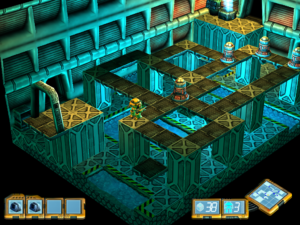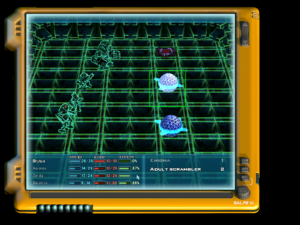Mirror’s Edge: First Person Issues
Looks like I’m not finishing Story Mode today after all. The game crashed in the middle of a recent session, and has since then has refused to start up. Sometimes I just get a splash screen and nothing else, sometimes it gives me an “illegal operation” error, once and only once did it start up successfully. I don’t know why this suddenly started happening after a period of trouble-free operation. Or, well, not quite trouble-free: I had problems at the very beginning with environmental sounds — traffic noises and the like — being entirely too loud and drowning out the voices. Apparently the game was trying to do things with point sound sources that my hardware didn’t support, and the solution was to turn off hardware sound acceleration.
Anyway, I said I’d post about the interface, and I can still do that. Platforming in first person presents some difficulty, especially when the game tries to create a sense of immediacy by shaking the camera, as happens whenever you break down a door in ME. Also, one of the moves you can do to avoid damage and maintain momentum is a tuck-and-roll at the end of a fall, which is rather disorienting, because the camera actually does a quick 360-degree pitch.
The thing I most anticipated having problems with was judging exactly when to jump when running toward the edge of a roof. In part, the game solves this by doing something rare for a first-person game: if you look downward, you can actually see yourself. Most first-person games — which are mostly shooters — display, at most, an arm holding a gun. I can think of only two other first-person games I’ve played that gave the player a visible body: Trespasser (the Jurassic Park game) and Montezuma’s Return (a 3D sequel to the classic 2D platformer Montezuma’s Revenge). Montezuma’s Return did it because, like Mirror’s Edge, it’s a first-person platformer; Trespasser did it out of a misguided sense of realism, which pretty much describes every design decision in Trespasser. At any rate, if you’re really worried about jumping at the right moment in ME, you can watch your feet while you run. But honestly, I haven’t found this necessary. If I find myself missing a ledge by inches, I find it’s more productive to just get a better run-up. Running in this game means accelerating, and a few extra feet of acceleration can mean a lot.
To me, the bigger way that the first-person view affects things is when you’re climbing ladders and pipes and the like. For a game with such gorgeous scenery, you spend a lot of time facing into walls. When you reach the end of a climb, you often need to twist the view around to locate the next pipe you need to jump to, and then your vantage can make it difficult to judge if it’s close enough and whether or not you’re actually pointed in exactly the right direction to grab it. The game has a clever way around this: when something can be grabbed, the player character will reach towards it with a visible hand. It took me a while to figure this out. It’s invaluable feedback once you recognize it, but I think it’s telling that tricks like this were necessary.
It’s been pointed out before that a more traditional over-the-shoulder view allows the sight of the player character’s body to substitute for a sense that’s otherwise lost in games: proprioception, the sense of one’s own body’s position. ME gives you occasional body glimpses, but proprioception isn’t constant. The people who say that ME is immersive partly because of its first-person view really have it backward: if it’s immersive, it’s in spite of the first-person perspective, because it’s found ways to overcome the limitations of its viewpoint and its lack of normal sensory information. And sometimes it fails at that. That roll move is disorienting in part because it temporarily takes away the intuitive sense of which way is up, something provided by by the way the camera movement normally works in the game, and by the sense of balance in real life.
 Comments(5)
Comments(5)
